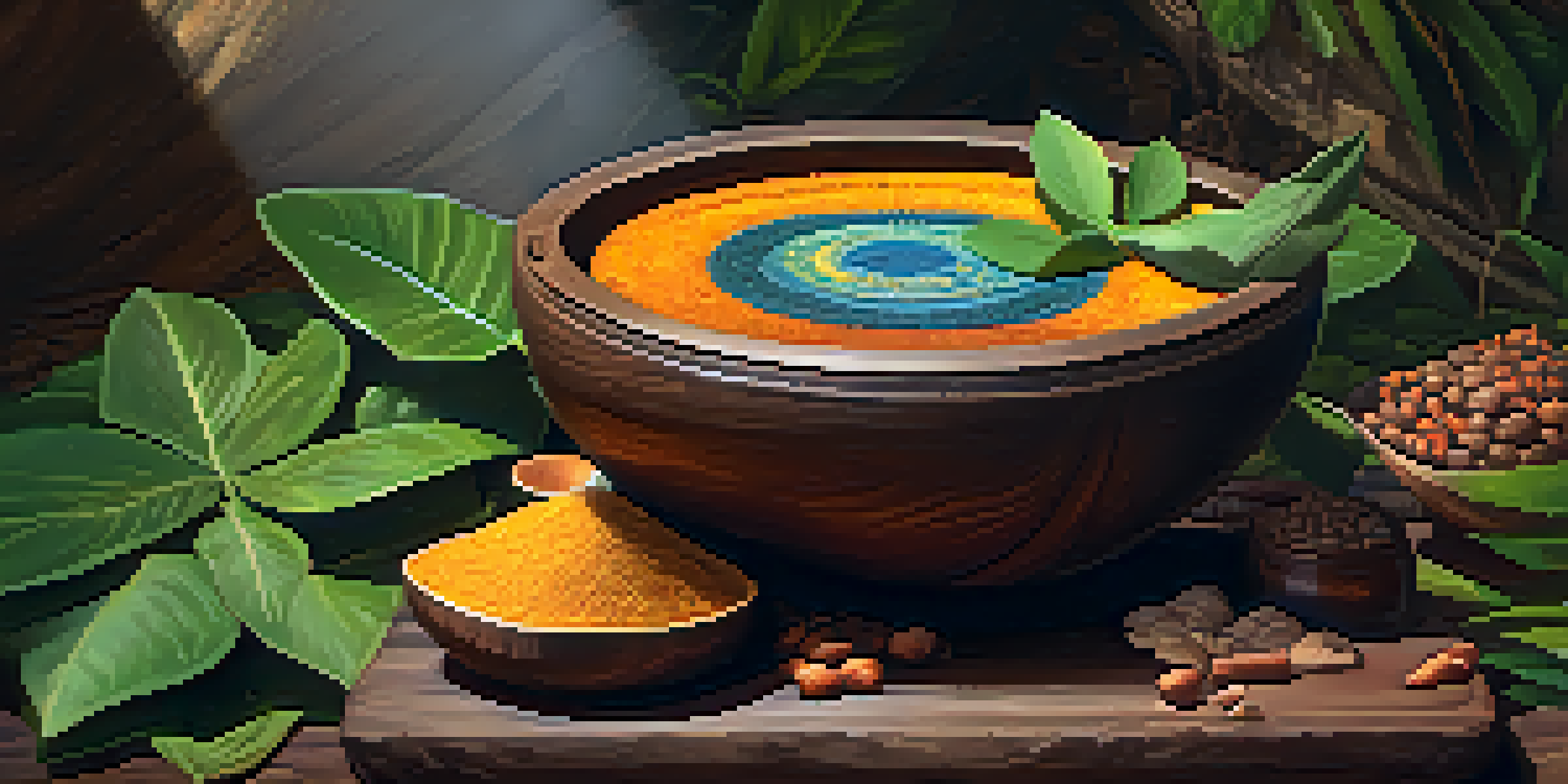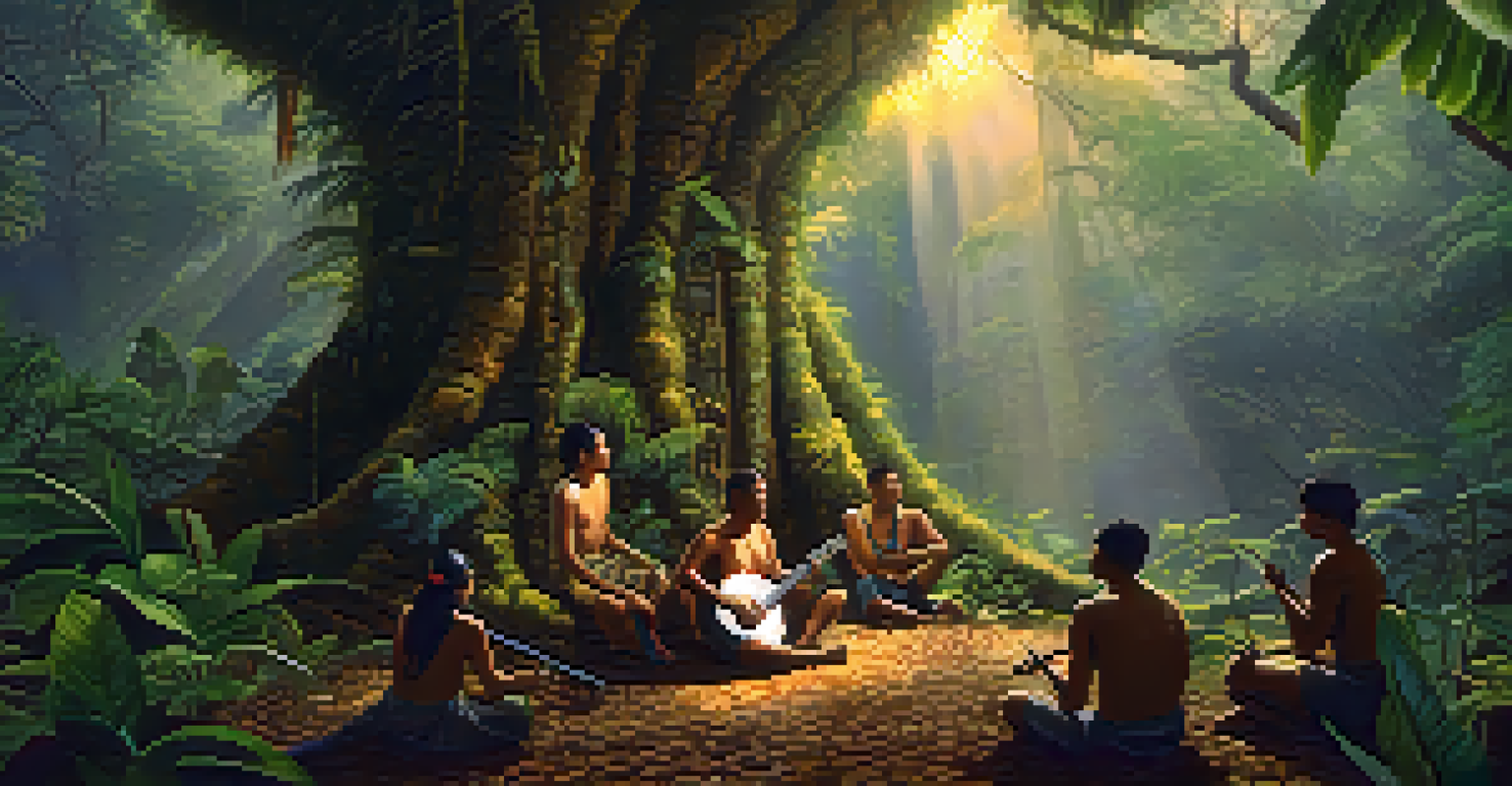The Relationship Between Music and Visuals in Ayahuasca

Understanding Ayahuasca and Its Cultural Significance
Ayahuasca is a powerful plant medicine used traditionally by indigenous Amazonian tribes. It is made from the Banisteriopsis caapi vine and the Psychotria viridis leaf, creating a brew known for its hallucinogenic effects. This ancient practice is often accompanied by rituals and ceremonies, emphasizing its deep cultural roots. Through these ceremonies, participants seek healing, guidance, and personal transformation.
Music can change the world because it can change people.
At the heart of the ayahuasca experience are not just the visions but also the sounds that accompany them. Music plays a pivotal role in these ceremonies, often performed by a shaman or facilitator. The melodies and rhythms can evoke emotions, create a sacred space, and help guide participants through their journey. This blend of music and spirituality enhances the overall experience, making it more profound.
Understanding the cultural significance of ayahuasca sets the stage for exploring how visuals and music interact. It's essential to recognize that this connection varies from person to person, influenced by individual backgrounds and experiences. As we delve deeper, we can see how these elements work together to shape the ayahuasca journey.
The Role of Music in Ayahuasca Ceremonies
In ayahuasca ceremonies, music serves multiple functions, from setting the mood to facilitating emotional release. The shaman often uses traditional songs, known as icaros, which are believed to carry spiritual significance and healing properties. Each icaros is unique, designed to resonate with the energies present in the ceremony and guide participants through their experiences.

Participants often report feeling a deep connection to the music, as it can evoke memories, feelings, and visions. The sounds can act as a bridge between the physical and spiritual realms, helping to navigate challenging moments during the experience. This musical connection can also foster a sense of community among participants, as they share a collective journey through sound and vision.
Ayahuasca's Cultural Roots
Ayahuasca is a traditional Amazonian plant medicine used in ceremonies aimed at healing and personal transformation.
Moreover, the rhythm and tone of the music can influence the depth and quality of the visual experiences. Many find that faster-paced music can lead to more intense visuals, while softer melodies may encourage introspection and calm. This dynamic interplay between music and visuals is an essential aspect of the ayahuasca experience, enriching its transformative potential.
Visual Experiences During Ayahuasca Journeys
The visual experiences during an ayahuasca journey can be both stunning and surreal. Many participants describe vivid colors, intricate patterns, and even encounters with mystical beings. These visuals are often reflective of one's inner thoughts and emotions, serving as a mirror to the soul. They can manifest as deeply personal symbols that carry significant meaning for the individual.
The arts have a unique ability to bring people together, to connect them to their inner selves and to one another, and to inspire them to be their best selves.
These visuals are not merely random; they often correlate with the music being played during the ceremony. For instance, a haunting melody might trigger a wave of emotional release, leading to visuals that depict the participant's struggles or triumphs. This synchronization creates a rich tapestry of experience, where sound and sight meld into a single narrative.
Additionally, the nature of these visuals can vary widely among participants, influenced by personal history, intention, and openness to the experience. Some may encounter healing imagery, while others may face challenging visions that require deep introspection. Understanding the relationship between these visuals and the accompanying music is crucial for grasping the full depth of the ayahuasca journey.
The Healing Power of Music and Visuals
One of the most profound aspects of the ayahuasca experience is its potential for healing. Participants often report significant emotional and psychological breakthroughs facilitated by the combination of music and visuals. This potent duo can help individuals confront past traumas, leading to a greater sense of peace and understanding.
Music, with its ability to evoke emotions, plays a vital role in this healing process. It can provide comfort during difficult moments, guiding participants through challenging emotions. As the visuals unfold, the music enhances the emotional landscape, allowing individuals to process their experiences in a deeply personal way.
Music Enhances Healing Experience
The integration of music, particularly traditional icaros, plays a crucial role in guiding participants through emotional and visual experiences during ayahuasca ceremonies.
Moreover, the insights gained from these experiences can lead to lasting changes in one's life. Participants may return from ceremonies with newfound clarity, motivation, and a sense of purpose. The healing power of music and visuals in ayahuasca ceremonies emphasizes the importance of these elements in promoting personal growth and transformation.
Personal Narratives: The Intersection of Music and Visuals
Many participants have shared their personal stories about how music and visuals intertwined during their ayahuasca experiences. For instance, one individual recalled feeling a profound sense of connection to the music, which accompanied a journey through their childhood memories. The melodies seemed to unlock doors to forgotten feelings, allowing for healing and resolution.
Another participant described a moment when the music shifted dramatically, leading to a visual transformation that mirrored their emotional state. As the tempo increased, so did the intensity of the visuals, revealing layers of complexity in their psyche. These narratives highlight how the interplay between music and visuals can create a rich, multifaceted experience.
These personal accounts not only illustrate the unique relationship between music and visuals but also emphasize the subjective nature of the ayahuasca experience. Each person's journey is distinct, shaped by individual emotions, memories, and the music that resonates with them. This diversity adds depth to the understanding of how these elements work together.
Scientific Insights: Why Music Affects Our Perception
While the ayahuasca experience is deeply personal and spiritual, scientific research sheds light on why music has such a profound impact. Studies suggest that music activates regions of the brain associated with emotion, memory, and even pain relief. This neurological response may explain why participants feel such strong connections to the music during their ayahuasca journeys.
Moreover, the phenomenon of synesthesia, where stimulation of one sensory pathway leads to automatic experiences in another, may help explain the interplay of music and visuals. Some research indicates that certain sounds can trigger visual imagery, creating a powerful blend of experiences. This cross-sensory activation can intensify the overall impact of the ayahuasca experience.
Visuals Reflect Inner Emotions
The vivid visuals experienced during an ayahuasca journey often mirror participants' inner thoughts and emotions, creating a deep personal connection.
By understanding the science behind music's effects on perception, we can appreciate its role in enhancing the ayahuasca journey. It also opens up avenues for further exploration into how sound can aid in emotional healing and personal growth, both within and outside of ceremonial contexts.
Conclusion: Embracing the Journey of Sound and Sight
The relationship between music and visuals in ayahuasca ceremonies is a captivating exploration of the human experience. As we have seen, music not only enhances the visual aspects of the journey but also serves as a powerful tool for healing and understanding. This interplay creates a unique environment where participants can delve into their innermost selves.
As more people seek out ayahuasca experiences, it becomes crucial to recognize the significance of both sound and sight. Embracing this relationship can lead to more profound insights and transformations. Each individual's journey is a tapestry woven with personal narratives, emotions, and the music that resonates within them.

Ultimately, the magic of ayahuasca lies in its ability to connect us to ourselves, each other, and the universe. By appreciating the intricate dance between music and visuals, we can deepen our understanding of these transformative experiences and the healing they offer.